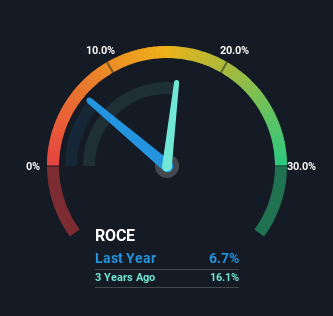- Australia
- /
- Commercial Services
- /
- ASX:SGF
SG Fleet Group (ASX:SGF) Could Be Struggling To Allocate Capital
To find a multi-bagger stock, what are the underlying trends we should look for in a business? In a perfect world, we'd like to see a company investing more capital into its business and ideally the returns earned from that capital are also increasing. If you see this, it typically means it's a company with a great business model and plenty of profitable reinvestment opportunities. In light of that, when we looked at SG Fleet Group (ASX:SGF) and its ROCE trend, we weren't exactly thrilled.
Return On Capital Employed (ROCE): What Is It?
For those who don't know, ROCE is a measure of a company's yearly pre-tax profit (its return), relative to the capital employed in the business. To calculate this metric for SG Fleet Group, this is the formula:
Return on Capital Employed = Earnings Before Interest and Tax (EBIT) ÷ (Total Assets - Current Liabilities)
0.067 = AU$169m ÷ (AU$2.7b - AU$221m) (Based on the trailing twelve months to December 2022).
Therefore, SG Fleet Group has an ROCE of 6.7%. On its own, that's a low figure but it's around the 7.5% average generated by the Commercial Services industry.
Check out our latest analysis for SG Fleet Group

Above you can see how the current ROCE for SG Fleet Group compares to its prior returns on capital, but there's only so much you can tell from the past. If you'd like, you can check out the forecasts from the analysts covering SG Fleet Group here for free.
What The Trend Of ROCE Can Tell Us
In terms of SG Fleet Group's historical ROCE movements, the trend isn't fantastic. Over the last five years, returns on capital have decreased to 6.7% from 18% five years ago. Although, given both revenue and the amount of assets employed in the business have increased, it could suggest the company is investing in growth, and the extra capital has led to a short-term reduction in ROCE. And if the increased capital generates additional returns, the business, and thus shareholders, will benefit in the long run.
Our Take On SG Fleet Group's ROCE
While returns have fallen for SG Fleet Group in recent times, we're encouraged to see that sales are growing and that the business is reinvesting in its operations. These trends are starting to be recognized by investors since the stock has delivered a 2.1% gain to shareholders who've held over the last five years. Therefore we'd recommend looking further into this stock to confirm if it has the makings of a good investment.
One more thing: We've identified 2 warning signs with SG Fleet Group (at least 1 which is a bit unpleasant) , and understanding them would certainly be useful.
If you want to search for solid companies with great earnings, check out this free list of companies with good balance sheets and impressive returns on equity.
New: Manage All Your Stock Portfolios in One Place
We've created the ultimate portfolio companion for stock investors, and it's free.
• Connect an unlimited number of Portfolios and see your total in one currency
• Be alerted to new Warning Signs or Risks via email or mobile
• Track the Fair Value of your stocks
Have feedback on this article? Concerned about the content? Get in touch with us directly. Alternatively, email editorial-team (at) simplywallst.com.
This article by Simply Wall St is general in nature. We provide commentary based on historical data and analyst forecasts only using an unbiased methodology and our articles are not intended to be financial advice. It does not constitute a recommendation to buy or sell any stock, and does not take account of your objectives, or your financial situation. We aim to bring you long-term focused analysis driven by fundamental data. Note that our analysis may not factor in the latest price-sensitive company announcements or qualitative material. Simply Wall St has no position in any stocks mentioned.
About ASX:SGF
SG Fleet Group
Provides motor vehicle fleet management, vehicle leasing, short-term hire, consumer vehicle finance, and salary packaging services in Australia, New Zealand, and the United Kingdom.
Undervalued second-rate dividend payer.
Market Insights
Community Narratives



